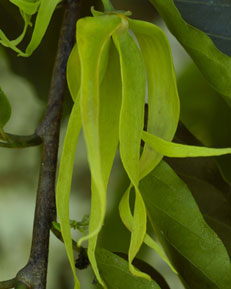
Photo © Steven Foster
Introduction
The oil of ylang ylang is derived from the pale yellow flower of Cananga odorata a tropical evergreen tree that can grow to 130 feet and is thought to have originated in Southeast Asia.1 Ylang ylang is native to tropical Asia, Australia, and several Pacific islands, and has been introduced into Africa, China, India and the Americas. The main exporters of ylang ylang oil are Indonesia, the Comoro Islands, Nosy Bé (an island off the northwest coast of Madagascar),1 and more recently, the Philippines.2 History and Cultural Significance
Throughout history, there have been many uses for C. odorata, varying by region. One of the earliest recorded uses was as an additive to coconut oil pomade in the Molucca Islands in 1866.3 The flowers have been used as both ceremonial decoration and personal ornamentation in Malaysia and Indonesia where the scent is very popular.1 Women in these regions also hide the flowers in their hair. In Bali, the flowers are used to scent clothes closets and bed linens, and in Thailand an infusion of the essential oil is applied after bathing.1 By far, the most popular use of ylang ylang has been as a constituent in floral perfumes, aromatherapy preparations, and other cosmetics. There are varying qualities of ylang ylang oil dependent upon whether they are from the first or later distillations. ‘Extra’ or ‘First’ grade comes from the first distillation, is the highest quality, and used in expensive, high quality perfumes. “Third” grade ylang ylang is produced from a later distillation, has a more tenacious scent, and is used in less expensive soaps and toiletries.1 Ylang ylang is considered the “Queen of perfumes”4 and its exotic and sensual aroma is a popular aphrodisiac even today.5 The oil is often used in aromatherapy to relieve stress and provide relaxation. Historically, the fresh flowers were used for asthma and colic, and were rubbed on the skin to prevent itching.6 The essential oil from the flowers, prepared by steam distillation, has been used to treat headache. The wood from the tree is used for making boxes in Sri Lanka, and rope is made from the bark in the Celebes.4 In Malaysia ylang ylang is mainly planted along roadsides for shade.1 Modern Research
In a small study conducted in 1999, feelings of stress were reduced by 50% from ylang ylang inhalation.7 Inhalation of the fragrance of ylang-ylang oil was associated with reduced pulse rate and blood pressure as well as increased alertness and subjective attentiveness in another small study.8 Future Outlook
Little information is available on the market statistics and sustainability of C. odorata. At the end of the 1980s, the Philippines, which had been the leading producer of ylang ylang oil prior to World War I, experienced a renaissance in the commercial production of the oil.2 In 1989, in the Philippine town of Anoa, in the province of Tarlac, the government planted 2500 hectares (about 6,178 acres) with 10,000 trees to provide a better income for the rural population. By 2005 the number of trees had increased to 20,000 and the town had built a quality distillation facility. Three kilos of flowers sold for 50 Philippine pesos (approximately $0.90) in 2003.2 To make 10 milliliters of oil (approximately 0.02 pint) requires a kilo (2.2 pounds) of flowers.9 A liter (just over 1 US quart) of Anao’s oil sells for $134 to $179 depending on the consistency.9 References
1 Oyen LPA, Dung NX, ed. Plant Resources of South-East Asia. Vol. 19. Bogor, Indonesia: PROSEA Foundation; 1999. 2 Bethge W. The Perfume-Tree Ylang-Ylang. Available at: http://home.arcor.de/be/bethge/ylangeng.htm. Accessed July 18, 2005. 3 Bown D. The Herb Society of America New Encyclopedia of Herbs and Their Uses. London: Dorling Kindersley Ltd; 2001. 4 Duke JA. Handbook of Medicinal Herbs. Boca Raton, FL: CRC Press Inc.; 1985. 5 Lawless, J. The Illustrated Encyclopedia of Essential Oils: The Complete Guide to the Use of Oils in Aromatherapy and Herbalism. Dorset, UK: Element Books, Ltd; 1995. 6 Parrotta JA. Healing Plants of Peninsular India. New York, NY: CAB International Publishing; 2001. 7 Fruend D. Does ylang ylang inhalation have a hypotensive effect on unmedicated resting blood pressure in individuals with borderline hypertension?[Unpublished dissertation] 1999. Cited in Buckle J. Clinical Aromatherapy. 2nd ed. Philadelphia, PA: Elsevier Science; 2003. 8 Hongratanaworakit T, Buchbauer G. Evaluation of the harmonizing effect of ylang-ylang oil on humans after inhalation. Planta Med. July 2004;70(7):632-636. 9 Alhambra SC. Growth potential of ylang-ylang oil. The Manila Times. July 24, 2004. Available at: http://www.manilatimes.net/national/2004/jul/24/yehey/business/20040724bus5.html. Accessed July 18, 2005.
|